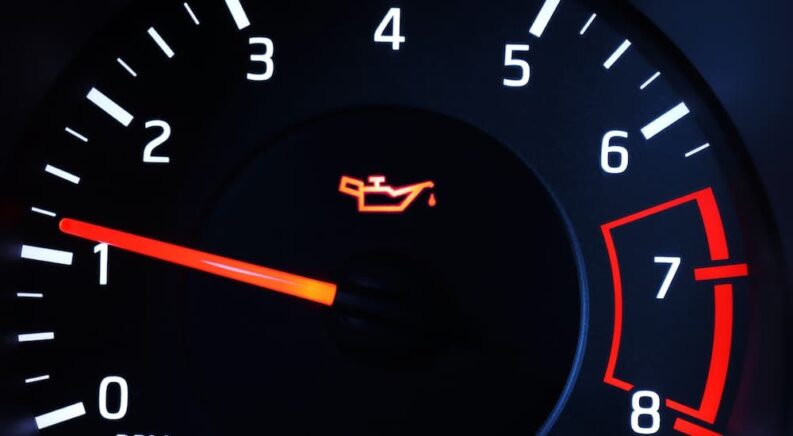Ask any driver when they should change their oil and they’ll almost reflexively answer with the standard 3,000 miles. This bit of automotive wisdom has been passed down through the ages, but it’s not as relevant as it once was. While 3,000 miles was once the benchmark for oil changes, advances in engine, oil, and additives now mean a vehicle running on a traditional motor oil or synthetic blend can go some 5,000 to 7,500 miles between appointments. The interval is even longer when using a fully synthetic oil, which is often rated to last 15,000 miles.
So, how do you know when it’s time to schedule an oil change? For many drivers, it’s as simple as paying attention to your oil life/quality monitor (OLM). Designed to track various factors like mileage, how a vehicle is being driven, and even the electrical conductivity of the oil, OLMs take the guesswork out of the oil change process. That said, the complexity and accuracy of these OLMs varies by brand. While some automakers like Chevrolet have embraced advanced OLM technology that uses sensors and complex algorithms to calculate oil life and quality, others rely on a simpler mileage-based method.
To be clear, an oil life/quality monitor is not the same as the oil temperature or pressure warning that might suddenly appear on your dashboard instrument cluster; these lights are designed to indicate an immediate, often serious problem related to the current oil temperature or pressure. Failure to acknowledge this warning can result in some costly repairs or outright engine failure, so it’s important to take a few minutes to familiarize yourself with all such warning lights.
So why is it important to pay attention to your car, truck, or SUV’s OLM? How do various offerings compare, and can they be trusted in the first place? We’ll address all those questions as we dive into everything OLM…
Can OLMs Be Trusted?
Today’s OLMs are certainly a convenient addition to your dashboard display, but can they be trusted, or are we being conned by the oil change industrial complex? While we’d all like to think that automakers are looking out for our best interests, there’s certainly something a little suspicious about a company that might have a vested interest in frequent oil changes dictating when they happen.
While OLMs range in accuracy and functionality, there is some data suggesting that many are pretty accurate, at least when it comes to adjusting for various operating conditions. A 2010 study by Edmunds.com examined the OLM in a 2007 Honda Fit Sport and returned some encouraging results. When subjected to mostly stop-and-go city driving, the Honda’s OLM popped on at around 5,500 miles, but when the same model was driven under highway conditions, it took around 7,600 for the OLM to suggest an oil change.
That extra 2,100 miles falls in line with the sort of accelerated oil degradation that comes with city driving, but there is one caveat: when Edmunds sent a sample of the oil for lab analysis, it found that it probably could have lasted another 2,000 miles with little issue. The findings were the same when testing the oil from a 2008 Pontiac G8 GT, which, like the Honda, probably had another few thousand miles of service.
While this might seem a little dubious, there are two qualifying factors to consider. First off, the test was performed on 2008 vehicles, which now practically qualify as antiques. OLMs have come a long way in the last 15 years, integrating new hardware, software, and algorithms to provide a more accurate reading. Secondly, the OLM underestimated the oil’s longevity rather than overestimate it; this is definitely the safer approach, and while it’s easy to ding the OLM for jumping the gun, most drivers would certainly rather change their oil a little prematurely than risk the serious damage that can come with acting too late.

Types of OLMs
OLMs were once little more than a sort of oil-centric odometer, and while some automakers still rely on this traditional approach, the technology has come a long way since it was first introduced in the late 1980s. Today, there are four basic types of OLMs, ranging from rudimentary to rather complex. The type of OLM you’ll find of a specific make and model is usually defined by the price. More affordable vehicles tend to offer fairly simple OLMs, while some luxury brands practically have a specialized oil-testing laboratory stuffed under the hood.
Let’s take a closer look at each of these four levels of OLM complexity and review some of the advantages and disadvantages of each. It’s worth noting that a vast majority of OLMs will be limited to Level 3 or lower, if there is an OLM at all. Some older models might lack the technology altogether, in which case you’ll be at the mercy of your own records or that little reminder sticker in the corner of your windshield.
Level 1: Mileage
A distance-based system is the oldest and simplest type of OLM on the market. These OLMs do little more than count down the mileage from a predetermined figure that’s been programmed at the factory and will alert drivers to an oil change with a warning light or message when it gets within a certain distance of that number.
Some systems might keep track of this number even when it has passed zero, letting drivers know exactly how overdue they might be. A distance-based OLM can’t account for different driving conditions, climate, load, or any other operating or environmental factors, which can lead to a less-than-accurate assessment of when an oil change might be required.
Level 2: Operating Conditions
Moving up a level, we have OLMs that are able to track some basic operating conditions; these usually include factors like whether a vehicle is being driven at a consistent highway speed or stop-and-go city driving, experiencing cold starts followed by short trips, or being subjected to high engine temperatures and heavy loads. An algorithm weighs these factors and, taking into account the mileage, decides when to send an alert to the driver.
Some more complex Level 2 OLMs can also integrate data from various engine sensors or even measure the concentration of ethanol in the fuel to give a more accurate reading. These conditions might not be excessively scientific, but they are shown to have some effect on oil life and are certainly an improvement over the purely mileage-based system used by Level 1 OLMs.
Level 3: Operating Conditions, Oil Level, and Temperature
Monitoring oil level and temperature can tell you a lot about the current state of the fluid. When exposed to high temperatures, the additives that impact wear protection and oil longevity can start to break down, which makes temperature a particularly important metric to track. A vehicle’s oil level doesn’t necessarily impact the life of the oil, but it can point to some important issues like accelerated wear, leaks, and mechanical failures. In addition to tracking oil level and temperature, a Level 3 system also monitors relevant operating conditions.
Level 4: Operating Conditions and Actual Oil Conditions
Those shopping on the luxury end of the market might be treated to a Level 4 OLM, which—in addition to monitoring mileage, oil levels and temperature, and operating conditions—can actually test the oil itself. This is often done using a sensor that can monitor the electrical conductivity of the oil. As oil starts to age, it can begin to absorb various byproducts of the internal combustion process, as well as small metal particles that come with normal wear and tear.
The sensor in a Level 4 OLM measures conductivity by passing a small charge through the oil. If this conductivity exceeds a certain threshold, the OLM is activated. Some brands go one step further, integrating sensors and systems that can measure additive depletion through contaminate build-up and acidity. These systems can even detect coolant or fuel in the oil, which is a valuable feature when it comes to avoiding some costly repairs.
How to Reset an OLM
OLMs might be a smart little piece of automotive technology, but sometimes they need a little help. Most OLMs will need to be manually reset after an oil change has been completed. This reset process varies by make and model. In some vehicles, it might involve turning the key and stepping on the accelerator, while others can be reset using a menu buried somewhere in the dashboard display or infotainment system. A quick look at your owner’s manual should lay out the process for your ride, which is yet another reason to study this handy guidebook.

Why Are Oil Changes Important?
Regular oil changes are an important part of any maintenance routine. Engine oil serves a vital role in keeping many of the moving parts of the engine cool, clean, and lubricated. This oil breaks down over time, losing its effectiveness due to heat, oxidation, dirt, dust, and other contaminants.
As the oil starts to break down, its viscosity will start to change, turning from a free-flowing liquid into a thick sludge that often fails to penetrate the further recesses of the engine. This process is natural, though it can be accelerated when certain components like the oil filter or engine air filter aren’t regularly changed.
Sticking to a regular oil change schedule can keep an engine running for hundreds of thousands of miles, whereas neglecting the task can turn an otherwise functional motor into an overheated hunk of scrap metal. Given the high stakes, why don’t drivers simply change their oil more often than the recommended schedule?
There are a couple of factors to consider, with cost being the main concern. Oil changes are relatively affordable at around $35, or around $75 for a synthetic blend and $100 for a full synthetic. There’s also the environmental factor, as motor oil can be difficult to dispose of, posing a serious environmental threat to waterways and aquifers; this has led states like California to advocate for longer intervals between oil changes, though no law to that effect has been passed to date.
Keeping your engine in good working order isn’t the only reason to maintain a regular oil change schedule. If your vehicle is covered by a manufacturer or dealer warranty, skipping an oil change can prove to be a costly oversight. Most warranty agreements require drivers to schedule regular oil changes in line with the manufacturer’s recommendations, and failing to do so is one of the easiest ways to void your warranty. It can be an expensive lesson—and one you certainly don’t want to learn the hard way—so make sure to comb over the warranty’s fine print whenever investing in a new vehicle.
Employing an Oil Life Monitor
An OLM is a handy way to avoid some of the worst oil-related outcomes, but it can’t actually extend the life of the oil. If you’re looking to maximize your mileage and not subject your engine to the stresses that can come with overworked oil, there are a few simple tips to keep in mind.
As we mentioned above, taking short trips—especially in sub-freezing temperatures—can be hard on the oil as it needs to warm up to effectively flow through the engine. Stop-and-go driving is another risk factor, as are hot or dusty weather conditions. A turbocharged or high-mileage engine tends to work through oil more quickly than a standard motor, as do vehicles that are frequently used for towing, hauling, or other heavy-duty applications.
While many of these scenarios are tough to avoid, they simply require a driver to be more mindful about performing regular oil changes. Your OLM might be able to help you out in this regard, though not all systems are going to be able to tell the difference between a rarely-driven pleasure vehicle and one that’s been put through its paces as a daily driver.
Ultimately, while an OLM can’t change your oil, it can play an important role in keeping you on the recommended maintenance schedule.

